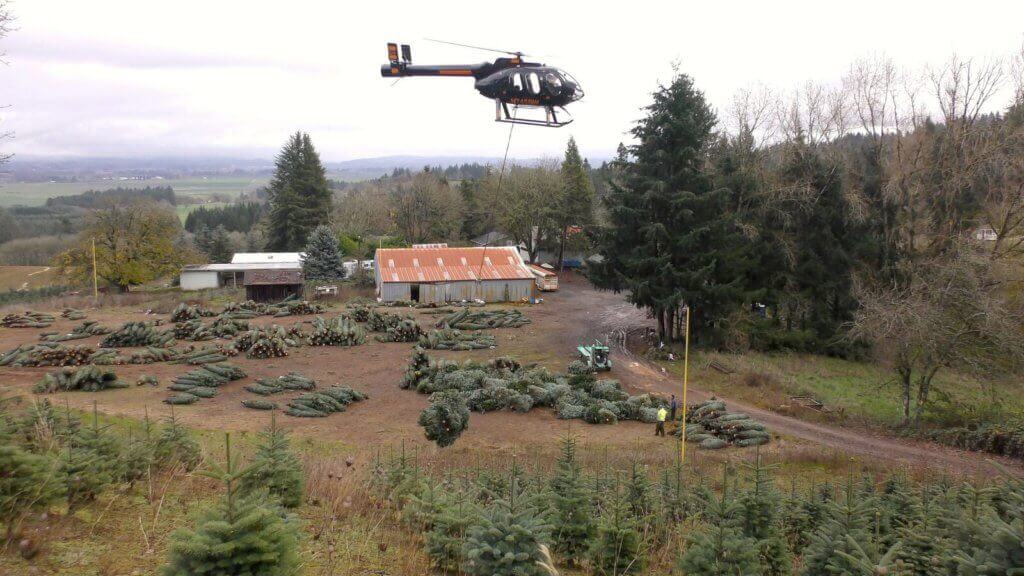One of the enduring symbols of the holiday season is the Christmas tree, with millions ending up in homes around the world each year as Dec. 25 approaches. While most trees are harvested in the “traditional” manner — by ground — many Christmas tree farms are reliant on the efficiency and unique capabilities of helicopters to help deliver their trees to market.
Oregon is the largest producer of Christmas trees in the United States, shipping trees not only across the U.S., but around the world. Vertical spoke with Burl Brim of Brim Aviation — one of the key operators in the annual Christmas tree harvest in Oregon — about the processes and aircraft that make these timely deliveries possible.

Brim operates a full MD NOTAR fleet of one MD 902, three MD 600Ns and one MD 520N. For the Christmas tree harvesting operations, the company uses the MD 600N because of its strong lift ability and efficiency of operation.
“The MD600N is our choice as our loads vary between 900 and 1,000 pounds,” Brim told Vertical. “[It] does the mission well; its rotor system is smooth and responsive, [it] has very good power, and [it] is pilot friendly for the repetitive nature of this mission.”
The number of trees harvested each hour is maximized by keeping the loads at the lighter end of the scale, with Brim aiming to collect roughly 1,000 trees per hour.
Brim said pilots must commit their full focus to the job due the speedy nature of the work, while using precise timing that is gentle enough to avoid damaging the trees. “I remember at the end of tree season my flying skills [were] finely honed with 120 hours of this fast-paced mission,” he said. “You get plenty of practice, so your precision flying skills become well honed.”
The muddy conditions in late fall make it difficult for ground crews to travel to, bundle, and transport the trees by truck. Tree growers have learned to appreciate the efficiency and ability of helicopters to keep processing costs down and production rates up by moving the trees directly to the handling and shipping facility. “With the turns per hour [that] we are able to make, the cost of helicopter operations is quite low in the overall scheme of things,” said Brim.
Additionally, the helicopters decrease the loss rate of trees as they are not “beaten up” by excess handling.
With each mission, the turns per hour can fluctuate depending on the type of tree field, and whether the trees are being loaded onto trucks or stockpiled. Typically, the helicopters will make a turn ranging from every 50 seconds to one minute and 30 seconds. However, they can load a tree in a truck in as little as 35 seconds from the pick.
“We work from early morning until the late afternoon moving bundles of trees,” said Brim. “During late fall, [the] days are shorter and the weather is everything from rain, snow, fog and sunshine, so we fly in all conditions and deal with low clouds and fog quite a bit.” Flights do not take place after dark, but Brim tries to squeeze as many hours out of the days as possible by starting work as soon as there is enough light.
The Oregon Christmas tree processing season typically begins around the middle of October and extends until around Dec. 10. However, the start of the season can depend on the Mexican sales market because the trees have to be shipped early in refrigerated trucks to arrive fresh in time for Christmas.
Brim hauls all types of Christmas trees, including noble fir, Douglas fir, pine trees, spruce trees, and silvertips. These trees range from three to 30 feet tall. In Oregon, the Willamette Valley is the center of Christmas tree production, but trees are grown from as far north as the Columbia River, all the way down to Roseburg.
These Christmas tree farms grow trees on hundreds or thousands of acres of land. A typical tree grows for roughly five years before the first harvest, but the larger trees take longer to grow to their specified size. Tree fields are managed so that a certain percentage of trees can be harvested each year, and then new trees are replanted in their place to ensure a continuous production cycle.









